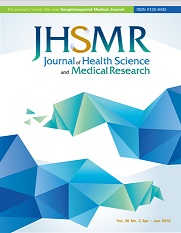Validation of SAD PERSONS Scale in Thai Tertiary Context
DOI:
https://doi.org/10.31584/jhsmr.2021785Keywords:
psychometric property, suicide risk assessment, SAD PERSONSAbstract
Objective: To examine the validity of the SAD PERSONS scale (SPS) and item analysis in a Thai tertiary setting.
Material and Methods: One hundred and twenty-six inpatients were recruited from a psychiatric ward. Patients were interviewed by a consultant psychiatrist and assessed a variety of suicide risk factors. The SPS was blindly performed by a psychiatric resident. The psychometric properties of SPS was executed by comparing the assessment results.
Results: A cut-off point of SPS was at 2/3 in assessing current high suicide risk with the sensitivity 79.0% and specificity 35.0%. While the specificity of cut-off point 4/5 was greater than 90.0%, sensitivity was only 27.0%. Parameters that correlated the high risk of suicide were only depression and statement of future suicide intent.
Conclusion: For the purpose of suicide prevention, a sensitivity of screening scale is essential. SPS failed to identify the majority of those requiring high intensity psychological intervention though it shows the high specificity of suicide risk. The instrument should not be applied to screen self-harm patients presenting to general hospitals.
References
World Health Organization. The global health observatory [homepage on the Internet] Geneva: WHO; 2019 [cited 2020 Feb 21]. Available from: https://www.who.int/gho/publications/ world_health_statistics/2019/EN_WHS_2019_Annex2.pdf? ua=1&ua=1
Larkin GL, Smith RP, Beautrais AL. Trends in US emergency department visits for suicide attempts, 1992-2001. Crisis 2008; 29:73-80.
Boudreaux ED, Camargo CA Jr, Arias SA, Sullivan AF, Allen MH, Goldstein AB, et al. Improving suicide risk screening and detection in the Emergency Department. Am J Prev Med 2016; 50:445-53.
Mitchell AM, Garand L, Dean D, Panzak G, Taylor M. Suicide assessment in hospital emergency departments: implications for patient satisfaction and compliance. Top Emerg Med 2005; 27302-12.
National Confidential Inquiry into Suicide and Safety in Mental Health. The assessment of clinical risk in mental health services [homepage on the Internet]. Manchester: The University of Manchester; 2018 [cited 2020 Feb 21]. Available from: https:// sites.manchester.ac.uk/ncish/reports/the-assessmentof-clinical-risk-in-mental-health-services/
Patterson WM, Dohn HH, Bird J, Patterson GA. Evaluation of suicidal patients: the SAD PERSONS scale. Psychosomatics 1983;24:343-5.
Tyrer P, Henderson F, McDermott U. Validation of rating scales in psychiatry. Br J Hosp Med 1993;49:434-7
Pierce DW. The predictive validation of a suicide intent scale: a five-year follow-up. Br J Psychiatry 1981;139:391-6.
Steeg S, Kapur N, Webb R, Applegate E, Stewart SL, Hawton K, et al. The development of a population-level clinical screening tool for self-harm repetition and suicide: the ReACT SelfHarm Rule. Psychol Med 2012;42:2383-94.
Spittal MJ, Pirkis J, Miller M, Carter G, Studdert DM. The repeated Episodes of Self-Harm (RESH) score: a tool for predicting risk of future episodes of self-harm by hospital patients. J Affect Disord 2014;161:36-42.
LeFevre ML, Force USPST. Screening for suicide risk in adolescents, adults, and older adults in primary care: U.S. Preventive Services Task Force recommendation statement. Ann Intern Med 2014;160:719-26.
Runeson B, Odeberg J, Pettersson A, Edbom T, Jildevik Adamsson I, Waern M. Instruments for the assessment of suicide risk: a systematic review evaluating the certainty of the evidence. PLoS One 2017;12:e0180292.
National Institute for Health and Care Excellence. Self-harm in over 8s: long-term management (Clinical guideline 133). [homepage on the Internet] London: National Institute for Health and Care Excellence; 2011 [cited 2020 Mar]. Available from: https://www.nice.org.uk/guidance/cg133/chapter/ Introduction
Quinlivan L, Cooper J, Davies L, Hawton K, Gunnell D, Kapur N. Which are the most useful scales for predicting repeat self-harm? A systematic review evaluating risk scales using measures of diagnostic accuracy. BMJ Open 2016;6:e009297.
Royal College of Psychiatrists. Self-harm, suicide and risk: a summary [homepage on the internet]. London: Royal College of Psychiatrists; 2010 [cited 2020 Apr]. Available from: https:// www.rcpsych.ac.uk/pdf/PS03-2010x.pdf
Bolton JM, Spiwak R, Sareen J. Predicting suicide attempts with the SAD PERSONS scale: a longitudinal analysis. J Clin Psychiatry 2012;73:e735-41.
Department of Mental Health, Ministry of Public Health. Annual report 2019. Bangkok: Ministry of Public Health; 2019.
Hockberger RS, Rothstein RJ. Assessment of suicide potential by non psychiatrists using the SAD PERSONS score. J Emerg Med 1988;6:99-107.
Wu CY, Huang HC, Wu SI, Sun FJ, Huang CR, Liu SI. Validation of the Chinese SAD PERSONS scale to predict repeated self-harm in emergency attendees in Taiwan. BMC Psychiatry 2014;14:44.
Saunders K, Brand F, Lascelles K, Hawton K. The sad truth about the SAD PERSONS scale: an evaluation of its clinical utility in self-harm patients. Emerg Med J 2014;31:796-8.
Quinlivan L, Cooper J, Meehan D, Longson D, Potokar J, Hulme T, et al. Predictive accuracy of risk scales following selfharm: multicentre, prospective cohort study. Br J Psychiatry 2017;210:429-36.
Chan MK, Bhatti H, Meader N, Stockton S, Evans J, O'Connor RC, et al. Predicting suicide following self-harm: systematic review of risk factors and riskscales. Br J Psychiatry 2016;209: 277-83.
Department of Mental Health, Ministry of Public Health. Committed suicide report [homepage on the Internet] Nonthaburi: Ministry of Public Health; 2016 [cited 2020 Apr]. Available from: https://www.dmh.go.th/report/suicide/stat_ sex.asp
Beck AT. Thinking and Depression: II. Theory and therapy. Archives of General Psychiatry 1964;10:561-71.
The Bureau of Registration Administration, Department of Provincial Administration. Thai population report 2019 [homepage on the internet]. Bangkok: Ministry of Interior; 2019 [cited 2020 Apr 16]. Available from: http://stat.bora.dopa.go.th/stat/ pk/pk_62.pdf
Tsirigotis K, Gruszczynski W, Tsirigotis M. Gender differentiation in methods of suicide attempts. Med Sci Monit 2011;17:65-70.
Fazel S, Runeson B. Suicide. N Engl J Med 2020;382:266- 74.
Wongsuraprakit S, Santiprasitkul S. Situtation of depression in pre-screened risk groups in Muang district, Chiang Rai province. Thai J Nursing Council 2012;27:91-105.
National Statistical Office Thailand. The food consumption behaviour survey. Bangkok: Text & J; 2017.
Schneider B. Substance use disorders and risk for completed suicide. Archives Suicide Res 2009;13:303-16.
























